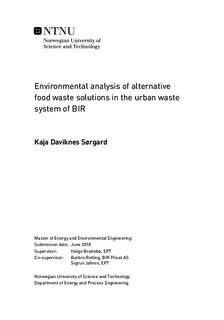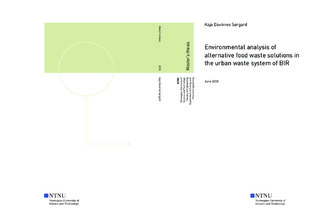| dc.description.abstract | The waste sector is appointed a key role in the transition towards a circular economy. The objective of the sector is shifting from solely handling the waste in an environmental and safe way, to encompass the preparation of resources being re-introduced in the economy. The waste sector is an important facilitator to achieve an increased recycling rate and circulation of resources and materials.
The objective of this thesis is to provide a holistic assessment of the effects of introducing food waste sorting in an urban waste management system. The main activity has been related to collection and processing of data used to analyze the urban waste management system of BIR (Bergen interkommunale renovasjonsselskap). The data is assessed with the use of a model developed and finalized by student Pieter G. Callewaert in 2017, under the supervision of Professor Helge Brattebø. The model is based on material flow analysis (MFA) methodology, with waste flow data from BIR as the input foundation. Furthermore, the model has an energy layer that requires case specific energy data for transport, incineration and other process treatment of the waste. In addition, an emission layer and a cost layer is computed manually based on the material and energy results computed by the model in addition to external, generic data.
Three system solutions for food waste treatment are modelled. The assessed alternatives are biogas production in Bergen, biogas production in Oslo and insect rearing in Voss (Hordaland). The performance in material recycling, energy recovery, emissions and cost-efficiency are compared and assessed.
The holistic assessment provides a range of results for all scenarios. The common features are an increase in material recycling and a decrease in the net emissions at the costs of a lower energy recovery rate (ERR) and higher expenses. The findings prove a rise in the overall material recycling efficiency in the BIR system from 20.9 % (reference) to 29.6 %, at best, when introducing food waste treatment. The best recycling result is achieved for the insect scenario, due to a simple technology with a low degree of losses. The insect scenario achieves a lower ERR than the biogas scenarios, and here the biogas Bergen scenario performs best due to lower transport requirements than biogas Oslo. The biogas scenarios also results in lower net emissions than the insect scenario, when including the fossil fuels that the biogas replaces. At the same time the insect scenario provides the cheapest system solution, but the biogas Bergen scenario is found to be the most cost-efficient scenario when comparing increase in costs per emission reduction. In other words, the results reflect the complex system assessed. Moreover, this assessment report provides an assessment of a novel treatment technology, insect rearing, to the field of food waste treatment in urban waste management systems. | |

